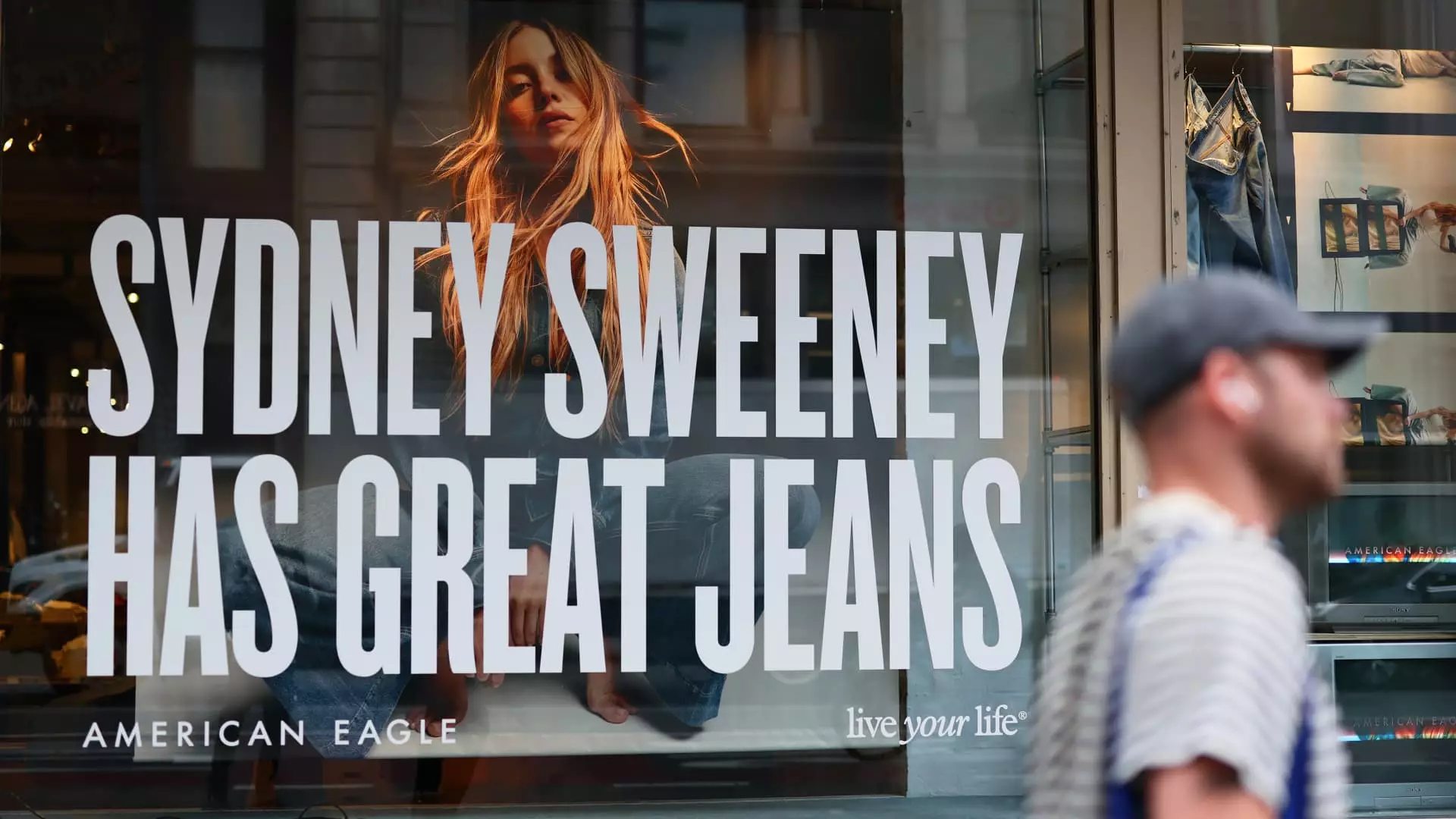In an era where brand identity is increasingly intertwined with political and cultural signals, the influence of celebrity endorsements extends far beyond mere marketing tactics. When figures such as President Donald Trump publicly commend a campaign, the ripple effects on consumer perception and stock performance can be profound. This phenomenon underscores a critical reality: in today’s polarized environment, endorsements—whether explicit or implicit—are loaded with ideological weight, which companies must navigate carefully.
American Eagle’s recent surge following Trump’s praise exemplifies how political figures can shape consumer behavior. The president’s recognition of actress Sydney Sweeney and her brand campaign revitalized investor confidence, causing shares to jump more than 15%, and eventually reaching an 18% increase during trading hours. Here, it’s evident that in the right political climate, endorsements from influential figures can serve as powerful catalysts—if leveraged correctly. However, this also exposes the inherent risk: aligning with a specific political message or figure can alienate segments of the market and potentially undermine long-term brand loyalty with a broader audience.
This situation invites a deeper reflection on the strategic use of endorsements. While some companies might see political figures as a shortcut to quick gains, the reality is that they often cast long shadows, influencing consumer perceptions in unpredictable ways. The American Eagle case demonstrates that a well-timed political nod can temporarily boost visibility and sales, but it also raises questions about authenticity, cultural alignment, and the risk of alienation. Is it advisable for brands to seek validation from partisan icons, or does it invite more harm than good?
Consumer Culture and the Political Divide
The controversy surrounding American Eagle’s campaign—particularly the slogan “Sydney Sweeney has great jeans”—illustrates a broader cultural fault line. Critics argued that the phrase was a double entendre, insinuating more about the actress’s appearance than her fashion sense. The backlash was not only rooted in moral positions but also in the perception that advertisers are increasingly detached from the sensibilities of mainstream audiences.
In a landscape where traditional marketing norms are challenged, companies find themselves at a crossroads: how do they appeal to a consumer base that is both diverse and divided? American Eagle’s attempt to celebrate body confidence and personal style has, in some quarters, been perceived as out of touch with evolving cultural standards. The criticism that the ad is sexualized or dismissive of broader social sensitivities is more than just a superficial flak—it signals a deeper societal shift: the decline of overtly provocative marketing that once defined youth culture.
Yet, the company’s response—stating that the slogan was solely about jeans—misses the mark in a highly scrutinized environment. Today’s consumers are highly perceptive; subtle signals and perceived intentions weigh heavily in brand trust. By ignoring these nuances, American Eagle risks marginalizing both its existing base and potential new customers, illustrating how difficult it is for brands to strike a balance that resonates without offending.
Marketing in the Crossfire of Cultural Ideologies
The marketing missteps seen in broader corporate campaigns—like Bud Light’s Dylan Mulvaney controversy—highlight the perilous tightrope brands walk in a polarized society. American Eagle’s campaign, although seemingly conventional, now exists within this same ideological battleground. Doing nothing—remaining silent—has become an increasingly risky strategy as well. Visibility, even if controversial, can ignite conversations that elevate brand awareness, but only if managed with a nuanced understanding of cultural currents.
The American Eagle scenario points to the limits of a “neutral” marketing stance in a climate where cultural representation and political correctness are hot-button issues. The company’s decision to push ahead with the campaign hints at a calculated gamble: that appealing to culturally conservative consumers might stabilize or grow its market share amid a declining sales environment. Search interest on Google indicates heightened curiosity about the brand, a sign that controversy or not, American Eagle’s efforts are resonating with consumers who appreciate the “traditional” values it signals.
However, the financial data paints a more sobering picture. Despite star power and social media buzz, American Eagle remains in a struggle for profitability, grappling with macroeconomic headwinds, declining sales, and inventory challenges. In essence, marketing can’t substitute for fundamental business strength. While social endorsements and cultural signals can temporarily boost profile, they can’t replace strategic product management and sound financial health.
Understanding the Political Economy of Retail Success
The American Eagle case serves as a stark reminder that cultural and political considerations are now integral to retail success. For brands rooted in center-right liberalism—balancing traditional values with modern consumer expectations—the key is authenticity. Aligning with figures like Trump, who symbolize certain cultural ideals, can generate short-term gains, but it also risks alienating a significant portion of the market. The challenge lies in crafting messaging that appeals to core demographics without veering into divisive territory.
In a fractured cultural landscape, marketers must adopt a strategic stance that recognizes consumers’ complexity, not simplifies them into monolithic groups. The balance of influence—be it through celebrity, political figure, or cultural signal—must be handled with prudence and an awareness of broader societal trends. Ultimately, the power of social endorsement demonstrates both opportunity and peril. When wielded wisely, it can invigorate a brand’s position; when mishandled, it accelerates decline and deepens divisions. The real art is in harnessing influence without succumbing to the temptations of provocative headlines and ideological extremes.

